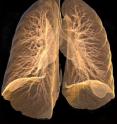New test could identify smokers at risk of emphysema
Using CT scans to measure blood flow in the lungs of people who smoke may offer a way to identify which smokers are most at risk of emphysema before the disease damages and eventually destroys areas of the lungs, according to a University of Iowa study. The study found that smokers who have very subtle signs of emphysema, but still have normal lung function, have very different blood flow patterns in their lungs compared to non-smokers and smokers without signs of emphysema.
This difference could be used to identify smokers at increased risk of emphysema and allow for early intervention. The findings appear this week in the Early Edition of the Proceedings of the National Academy of Sciences.
"We have developed a new tool to detect early emphysema-related changes that occur in smokers who are susceptible to the disease," said lead study author Eric Hoffman, Ph.D., UI professor of radiology, internal medicine and biomedical engineering. "Our discovery may also help researchers understand the underlying causes of this disease and help distinguish this type of emphysema from other forms of chronic obstructive pulmonary disease. This type of CT scan could even be a tool to test the effectiveness of new therapies by looking at the changes in lung blood flow."
As many as 24 million Americans have chronic obstructive pulmonary disease (COPD) -- a group of serious lung diseases that includes emphysema -- and COPD is the fourth leading cause of death nationwide. Because COPD is a group of different diseases, identifying more effective treatments may hinge on distinguishing between these diseases and targeting them separately.
The team used multi-detector row CT imaging to measure blood flow patterns in the lungs of 41 study participants -- 17 non-smokers and 24 smokers. All the participants had normal lung function, but 12 of the smokers had very subtle signs of emphysema. The CT scans showed that these 12 individuals had the most disrupted patterns of blood flow compared to the other participants.
The findings also support the idea that abnormal blood flow occurs before emphysema develops.
"Although the underlying causes of emphysema are not well understood, smoking increases the risk of developing the disease," Hoffman said. "Our study suggests that some smokers have an abnormal response to inflammation in their lungs; instead of sending more blood to the inflamed areas to help repair the damage, blood flow is turned off and the inflamed areas deteriorate."
The cellular pathway that turns off blood flow is helpful when an area of the lung has become permanently blocked and cannot be rescued. In that case, the lung "optimizes gas exchange" and stops supplying the area with blood. However, lung inflammation caused by smoking can be resolved and resultant damage repaired by increased blood flow, which brings oxygen and helpful cellular components to the site of injury.
This study suggests that the ability to distinguish when to turn off or when to ramp up blood flow is defective in some people -- probably due to genetic differences. If this genetic difference is coupled with smoking, which increases lung inflammation, that could increase the risk of developing emphysema.
Source: University of Iowa - Health Science
Articles on the same topic
- Researchers discover new approach for identifying smokers at highest risk for developing lung cancerWed, 7 Apr 2010, 18:42:33 UTC
Other sources
- Developing Test To Warn Smokers Of Cancer Dangerfrom CBSNews - ScienceThu, 8 Apr 2010, 16:21:33 UTC
- Developing Test To Warn Smokers Of Cancer Dangerfrom CBSNews - ScienceThu, 8 Apr 2010, 15:49:28 UTC
- Developing test to warn smokers of cancer dangerfrom AP HealthThu, 8 Apr 2010, 5:21:27 UTC
- Developing Test To Warn Smokers Of Cancer Dangerfrom CBSNews - ScienceThu, 8 Apr 2010, 4:56:11 UTC
- Developing Test To Warn Smokers Of Cancer Dangerfrom CBSNews - ScienceWed, 7 Apr 2010, 23:21:16 UTC
- Airway swab may predict lung cancer riskfrom CBC: HealthWed, 7 Apr 2010, 22:56:13 UTC
- Developing test to warn smokers of cancer dangerfrom AP ScienceWed, 7 Apr 2010, 19:35:26 UTC
- Researchers discover new approach for identifying smokers at highest risk for developing lung cancerfrom PhysorgWed, 7 Apr 2010, 19:14:47 UTC
- Identifying smokers at highest risk for developing lung cancer: Researchers find new approachfrom Science DailyWed, 7 Apr 2010, 19:14:25 UTC
- New test could identify smokers at risk of emphysemafrom PhysorgTue, 6 Apr 2010, 18:42:24 UTC
- New test could identify smokers at risk of emphysemafrom Science DailyTue, 6 Apr 2010, 15:28:31 UTC
